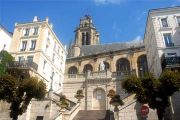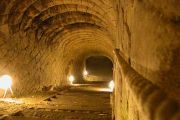One of France’s major towns in the Middle Age, Pontoise boasts a rich and varied heritage. Located on the banks of the river Oise, it was an Impressionists hangout at the end of the 19th century.
[ Practical ]
Getting there
- By road
30 km from Paris on autoroute A86 till exit 9.
- By train
Train from Paris Gare du Nord. The journey takes 45 mn.
RER C from Paris.
Getting around
All sights are within walking distance
Restaurants
La Belle Entente
Le Montecristo
L’Ardoise
Musée Tavet Delacour
4 rue Lemercier.
Open Wednesday to Sunday from 10am to 12.30pm and from 1.30pm to 6pm.
Admission : €5 / €3.
Musée Pissaro
17 rue du Château.
Open Wednesday to Sunday from 2pm to 6pm. Admission free.
Information
Pontoise Tourist Office
Tel : 0134417060
www.ot-cergypontoise.fr
Who remembers today that Pontoise was once a favourite residence of French kings and artists ?... Very few people for sure because this town located 30 km north-east of Paris is now part of the suburbs. Moreover, it is often seen as a modern city since the creation of the new town of Cergy-Pontoise in the 70s.
Yet, labelled “Ville d’Art et d’Histoire”, Pontoise boasts various monuments inherited from a glorious past and is worth a visit.
 Strategic position Strategic position
Arriving from Paris by train, the first sight of the town is a rocky promontory surrounded by ramparts. Called Mont Bélier, it overlooks the right bank of the Oise where a road linking Paris to Rouen since the Roman times crosses the river. So, it was a strategic position and a commercial crossroad for centuries. During the 11th and 12th centuries, when English had their hands on Normandy, it was even a key post for the defence of Paris and a powerful castle was built on the top of this promontory. But, as it later became useless, it was abandoned and finally destroyed in 1740. Nowadays, the esplanade where it stood is occupied by a public garden offering a panoramic view over the town and the Oise valley. It comprises a garden of the five senses adapted for visually impaired people where you are invited to touch and smell a large array of aromatic plants and plants with a particular texture.

 Hermitage district © T.Joly Hermitage district © T.Joly
|
 The Hermitage, a source of inspiration The Hermitage, a source of inspiration
It is also lined with beautiful 19th century wealthy houses including one that has been turned into the Pissarro Museum. In spite of its name, it holds only one canvas by the famous Impressionist painter as well as few etchings but due to their fragility they are not exhibited very often. However, there is also a canvas by Signac, one by Daubigny, another one by Guillaumin as well as paintings by less known impressionist and post-impressionist painters like Ludovic Piette. All have one common point, they often came to Pontoise – only 7 km away from famous village of Auvers-sur-Oise - at the end of the 19th century and at the beginning of the 20th century. The most regular – hence the name of the museum – was Pissarro who lived there from 1866 to 1869 and then from 1872 to 1883 producing more than 300 works depicting the town and the surroundings. In particular the Hermitage neighbourhood that still retains a bit of its former rural character with little alleys, a few vegetables gardens, old and modern wealthy houses.

 Hôtel d’Estouteville © T.Joly Hôtel d’Estouteville © T.Joly
|
 Well-preserved upper town Well-preserved upper town
A fine example of contemporary architecture inaugurated in 2005, the vast justice hall stands at the edge of this district and the historical centre. A maze of narrow and winding streets, the upper town is the most picturesque area and historical films are regularly shot there. In addition, it concentrates the main monuments to visit such as the Hotel d’Estouteville, a pretty late 15th century private mansion with turrets. For centuries the place of residence of the vicar of Pontoise, it is now the Tavet Delacour museum that holds an interesting collection of modern art mainly made up of works by Otto Freundlich. A German painter, sculptor and stained-glass designer of the first generation of constructivist and abstract artists, he lived in Pontoise and, after his death, his wife donated his private collection to the museum.

 Saint Maclou cathedral © T.Joly Saint Maclou cathedral © T.Joly
|
 Gothic and Romanesque cathedral Gothic and Romanesque cathedral
Works on display also includes paintings and sculptures by artists such as Matisse, Hans Arp and Diego Giacometti.
A few steps away from there, the city hall occupies the site of the former Cordeliers convent, whose the cloister and remains of the church have been incorporated in the present building. Parts of the medieval ramparts are also visible in the town largest public garden laid out in their moats. From there a narrow lane leads to the square where stands the Saint Maclou cathedral that is a combination of different architectural styles : Romanesque, flamboyant gothic, renaissance. Among the works of art adorning its interior, have a look at the beautiful 16th and 19th centuries stain-glasses and particularly to the one depicting Saint Louis’ vow. It’s indeed during a stay in Pontoise, in 1244, while seriously ill, that this French king vowed to go on crusade in case he would recover.
 Religious monuments Religious monuments
This event took place in the Maubuisson Cistercian abbey founded by his mother and now located on the territory of the neighbouring town of Saint-Ouen l’Aumone about 2 km away. Retaining some of its original buildings, surrounded by a nice park, it now hosts contemporary art exhibitions and is worth a detour.
In Pontoise itself, two other religious buildings of interest are visible in the lower town spreading around the railway station. One is a Carmelite convent, the second one founded in France and the oldest still in activity. Only the chapel can be visited as nuns still have traditional life there. As to the other, it is the Notre-Dame church built in 1590 and once a famous pilgrimage destination. It holds the chapel of the Miraculous Virgin and the tomb of Saint Gautier dating back to the 12th century.

 Underground gallery © Ville de Pontoise Underground gallery © Ville de Pontoise
|
 Underground heritage Underground heritage
Last but not the least, Pontoise also boasts and amazing underground heritage. From the 12th to the 15th centuries, many buildings were indeed constructed with limestone extracted from quarries located beneath the plateau where spreads the town. Afterwards, these underground cavities were used as cellars, merchant warehouses, hideouts and troglodyte dwellings. Columns and vaulted ceiling were even added in some of them like the Cave des Moineaux that spreads over three levels. As a few other ones, it is only open on Sunday for guided tours organized by the tourist office.
February 03, 2012
Thierry Joly 

|



